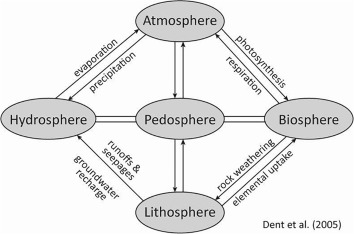Difference between revisions of "Pedosphere"
| Line 10: | Line 10: | ||
=='''Subsphere Interactions''' == | =='''Subsphere Interactions''' == | ||
| − | ''Atmosphere | + | ''Atmosphere'' |
The gaseous exchange between the pedosphere and atmosphere is at all times in equilibrium. Carbon dioxide is the most commonly exchanged gas between the spheres because of high microbial CO2 production and CO2 release from [[root hairs]]. Other exchanges between the two include rainfall and aeolian sedimentation, or wind erosion/weathering. | The gaseous exchange between the pedosphere and atmosphere is at all times in equilibrium. Carbon dioxide is the most commonly exchanged gas between the spheres because of high microbial CO2 production and CO2 release from [[root hairs]]. Other exchanges between the two include rainfall and aeolian sedimentation, or wind erosion/weathering. | ||
''Biosphere'' | ''Biosphere'' | ||
Revision as of 07:38, 25 April 2022
Definition
The pedosphere is the uppermost layer of the Earth's crust and is compromised entirely of soil layers. It is the hub that connects the lithosphere, atmosphere, hydrosphere, and biosphere.[1] It is contained within Earth's critical zone, a larger concept including vegetation, groundwater sources, rock layers, and the pedosphere. All terrestrial life on Earth lives on or within the pedosphere.
Pedogenesis
The formation of the pedosphere, or pedogenesis, requires multiple factors, taking from the four different planetary subsystems, or spheres. The air above the soil, living organism interactions, water inside, on top of or below the soil, and unconsolidated, superficial rock deposits. Layer formation begins with mechanical and chemical weathering of minerals in order to form regolith. Organic reactions from biological sources such as lichen and moss increase the rates of decomposition of the initial materials. Once the soil material has accumulated, water enters the system causing nutrient movement and ion exchange. The geochemical makeup of the soil then moves away from the parent material and reflects more of the biological processes taking place. The time it takes for this process to form one inch of soil is 500 years.[2]
Subsphere Interactions
Atmosphere
The gaseous exchange between the pedosphere and atmosphere is at all times in equilibrium. Carbon dioxide is the most commonly exchanged gas between the spheres because of high microbial CO2 production and CO2 release from root hairs. Other exchanges between the two include rainfall and aeolian sedimentation, or wind erosion/weathering.
Biosphere
